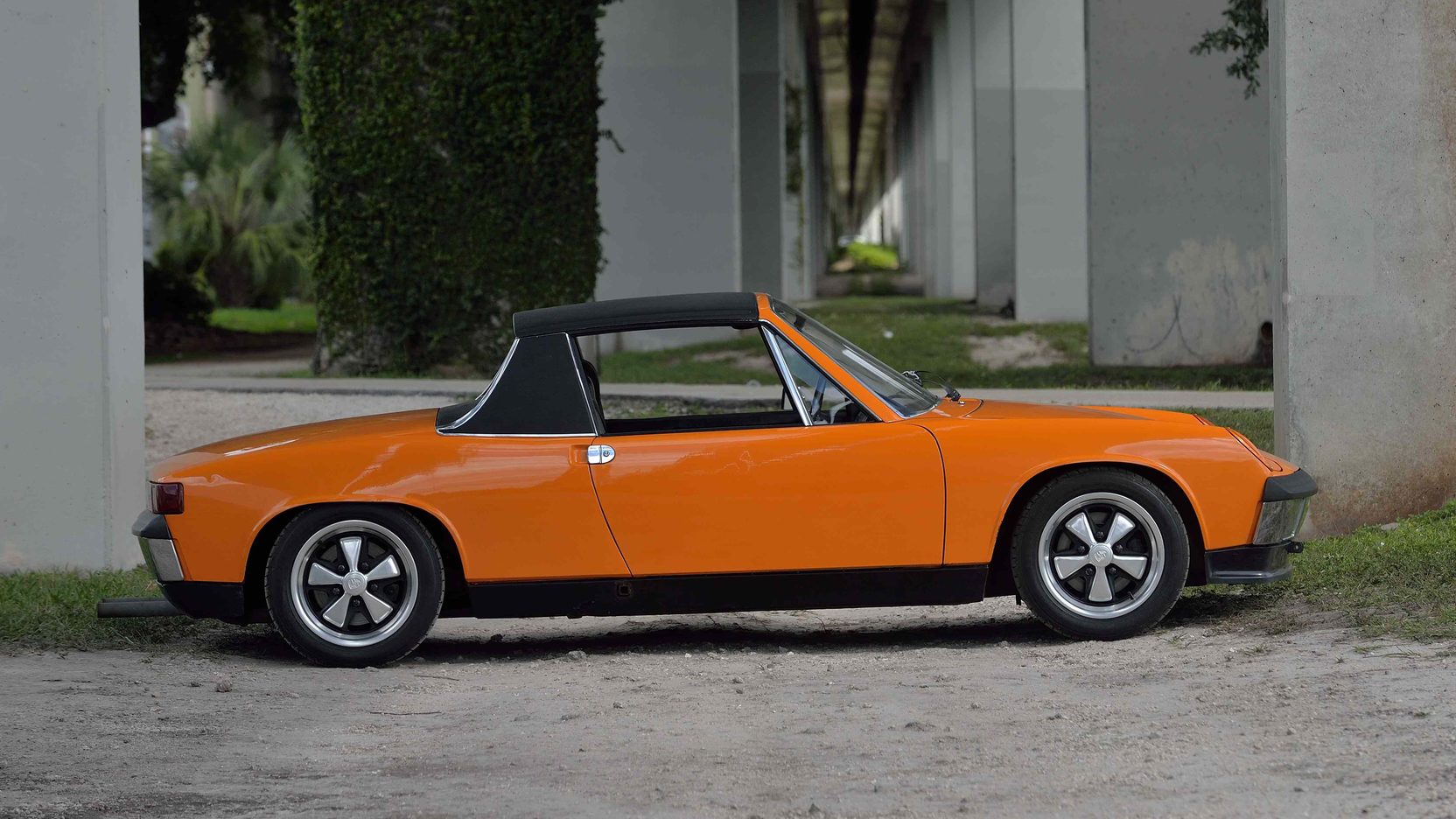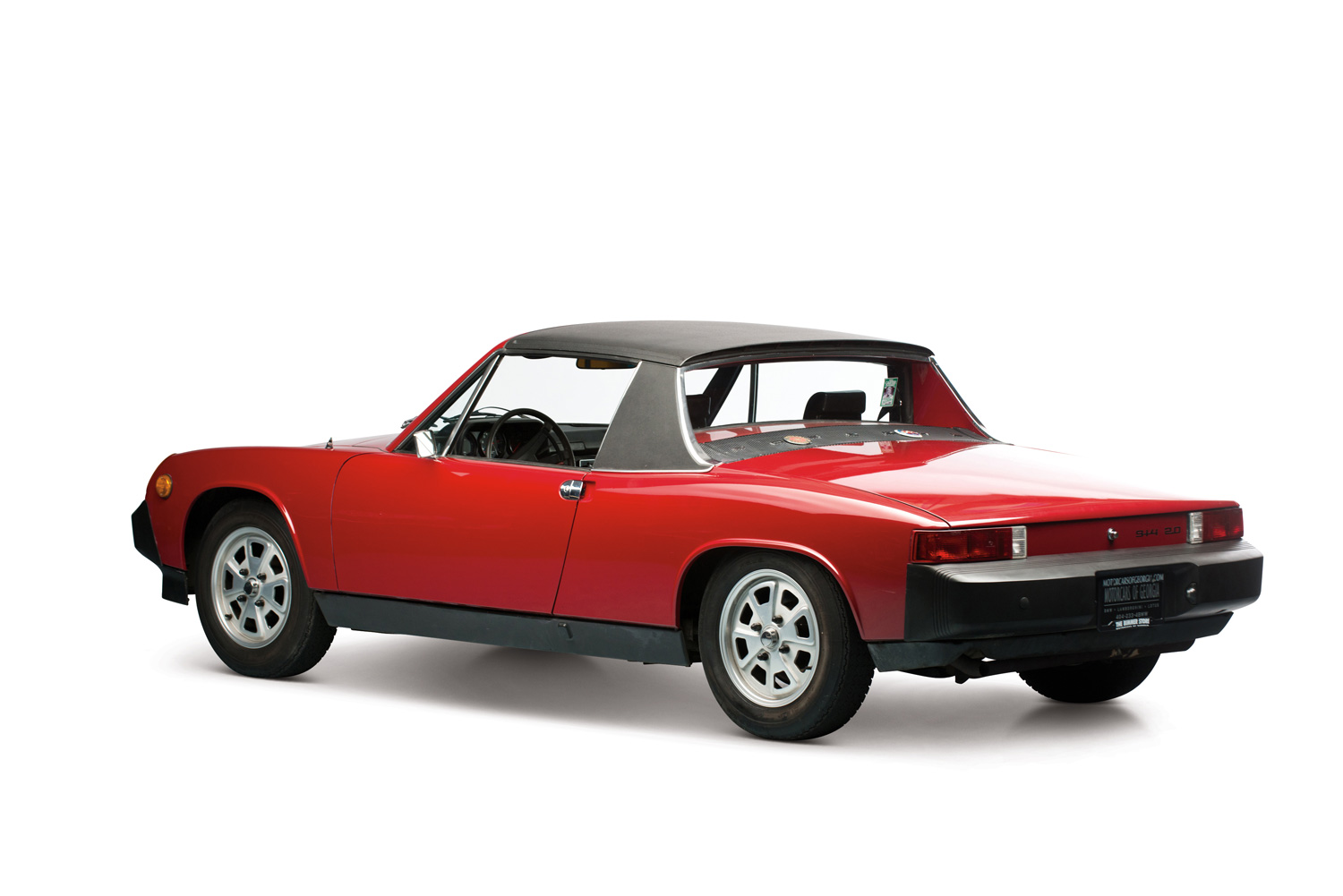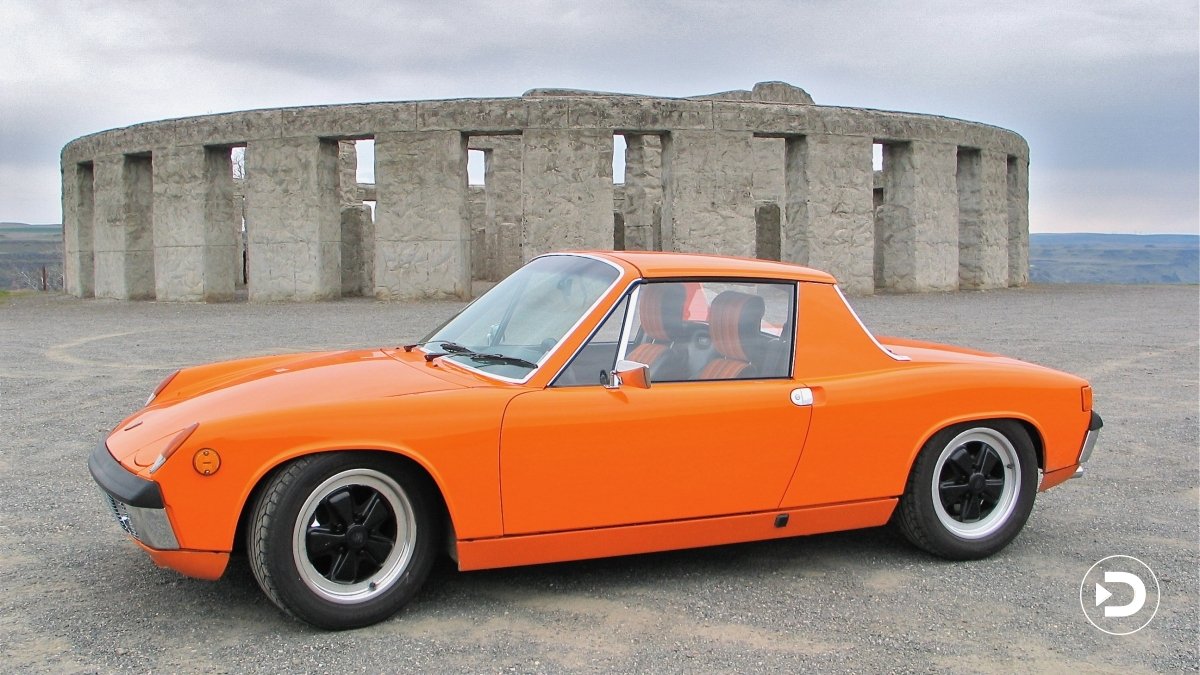Why the Porsche 914 still puts a grin on your face
At the turn of the key and a firm prod of the throttle, the boxer flat-four behind my head let out a pleasant, throaty growl. After a few seconds it settled into the upbeat pitter-patter of a happy engine. Before hitting the road, I reminded myself of the unique Porsche five-speed shift pattern: first gear from neutral is left and downward, reverse is above first.
I won’t lie: I’ve never owned a Porsche of any kind, but I’ve driven a few by borrowing them on DriveShare, and the 914 stuck out because of a few charming peculiarities. Much like the early ’80s 911s I’ve had the pleasure of piloting, the pedal placement is offset toward the center of the car (in comparison to my old American-made jalopies), but I quickly grew to appreciate the positioning; it made blipping the gas between downshifts effortless. There was some vagueness in the gear changes from first, to second, and then to third using the 1972 914/4 dog-leg gearbox, but I simply focused on my shifting and it soon became second nature. Later, I learned that this lack of feedback is a result of the many linkages required to connect the shifter to the rear-mounted transaxle.
The world appeared somehow larger as I accelerated down the road, soaking up the view through the tall, upright windshield. The exhaust’s rumble heightened with each climbing rev. The low seating position increases the sensation of speed, and when the engine hit peak power at 5000 rpm, a giggle escaped my lips before the upshift into fifth. The steering wheel felt large in my hands, and the mechanical steering’s lively, unfiltered feedback through corners produced a spectacular grin on my face.
When parked, the Porsche 914 looks a bit like a Swiss Army knife. There are cargo compartments both in the front and in the rear, and the frunk holds the spare tire and a few other select parts. Inside, the cabin is roomy (no shoehorn required) and remains comfortable for even for long-legged individuals, despite its low stature. It sits four inches lower than the 911s of its generation, but is an inch and a half wider; the 914’s wheelbase is seven inches longer in order to accommodate the higher-spec six-cylinder and to allow for serviceability. Exterior overhangs were trimmed to a bare minimum, so the overall length is seven inches shorter than the 911 despite the longer wheelbase. The mid-engine chassis offers near-perfect weight distribution, which, paired with the car’s light curb weight (2029 pounds), gives the 914 an extra edge on windy roads.
The rise of the 914
20191030191801)
By partnering with Volkswagen to use existing VW engines, Porsche designed a more affordable driver’s car and bridged the gap between the more expensive 911 and the dated 912, which was no longer competitive against cars like the Datsun 240Z. In turn, Volkswagen gained a sportier car for its lineup which allowed it to cut the 1500 Karmann Ghia. The 914 sold in the United States under the Porsche name, but in the rest of the world it was marketed as a VW-Porsche.
It didn’t take long for the Porsche 914 to win over enthusiasts and the automotive press after its release. In 1970, Motor Trend named the Porsche 914 Import Car of the Year, saying, “The 914 doesn’t feel remotely like any VW you have ever driven. All Porsche has done is return to an inexpensive, reliable engine and at a lower price than before.”
The on-rails handling of 914s encouraged people to drive them hard. The platform was a fantastic autocross machine if not for the under-powered flat-four, so many of the cars were stripped down and modified to be competitive on track. Luckily, original examples are still plentiful, but like most Porsches, the values have increased exponentially in the last few years. Not sure which 914 variation to pursue? We’ve got you covered: Let’s explore the different variations of the 914 throughout its six-year production run.
The nitty-gritty

All model years, from 1970–76, shared a unitized steel body, a fixed Targa-type rollover bar, and disc brakes on all four wheels. The fiberglass roof section is easily removed and stored in the rear luggage compartment. The five-speed gearbox was taken from the 911, then flipped around with the ring gear installed on the opposite side of the pinion gear. During the 914’s six years of production, the cas remained relatively the same, but Porsche did make minor improvements along the way.
1970–72 Porsche 914/4

The first of the four-cylinder cars used an 80-horsepower 1.7-liter flat-four 411E engine from the Volkswagen bus. It hit 60 mph in a leisurely 13.7 seconds, seven seconds slower than the 911 of its time. An optional appearance package included chrome bumpers and vinyl-covered rear roof pillars. On the standard-trim cars, the panels were painted body color. Standard wheels were silver-painted Volkswagen rims with plain chrome hubcaps. Pedrini alloy wheels were optional, yielding a slightly wider stance. The interior was simple, so much so that the seats were not adjustable for the 1970–71 model years. To make up for this, there was a removeable footrest for shorter drivers.
In 1971 the windshield wiper and washer controls on the standard car moved from the instrument panel to the steering wheel column to match the 914/6, and the glovebox knob was enlarged. This was also the year of adjustable air outlets on either side of the dash, an adjustable passenger seat, and improved insulation and sound deadening. If you’ve never driven an early 914, the 1972 model is an experienced we’d highly recommended.
1970–72 Porsche 914/6

The 914/6 was considerably quicker than its four-cylinder sibling. The 2.0-liter flat-six engine’s 110-hp output was identical to that of the 1969 911T from which it came, and meant the 914/6 could hit 60 mph in around 8 seconds. Just 3300 or so were built—the rarest examples were equipped with a Sportomatic transmission, of which only 25 were released between 1970 and 1971.
There were few visual cues that differentiated the 914/6 from the 914/4, aside from the obvious 914-6 script on the tail panel. For starters, the 914/6 had chrome bumpers, external trim strips, and vinyl-covered rear roof pillars. It was also equipped with wider 5.5 x 15-inch, 10-spoke, five-lug steel wheels as opposed to the four-lug wheels on the 914/4. Other wheel options included chrome-plated steel wheels, cast Mahle alloys, and forged Fuchs alloy wheels. A few differences weren’t obvious at first glance, including as the three-speed windshield wipers and electric windshield washers (the 914/4 had hand-activated pneumatic windshield washers). The 914/6 was also equipped with a headlight flasher, dual-tone horns, and a hand throttle used to help set the choke when the car is warming up.
Only available with the 914/6 model between 1971–72 was a rarely-seen M471 option package that offered a widebody appearance made possible by flaring all four fenders and adding flared fiberglass rocker panels and a wider steel front valance. The rear valance was also deleted. Spacers and longer wheel studs were added to make room for larger 6.0 x 15-inch Fuchs forged alloy wheels.
1973 Porsche 914 1.7

For 1973 the 1.7-liter engine remained standard and a four-cylinder 2.0-liter was offered as an option in place of Porsche’s six-cylinder 2.0—hence the factory designation change from 914/4 to 914 1.7 for the base car. The engine options were scripted on the car’s tail panel to easily differentiate between the two.
This year was a turning point for the 914; the vague-feeling shift linkage was improved, and drivers could finally adjust their seats. The standard trim package now featured black bumpers, and chrome bumpers paired with upholstered roof pillars were again offered as an appearance upgrade. Safety standards became stricter, and with that came unsightly rubber bumper guards in the front. Standard wheels were the same as the earlier 914/4, but additional options were available. Options included a wider steel wheel, plus the Pedrini and Mahle cast alloy wheels, and the Fuchs four-spoke forged alloy wheels.
1974–75 Porsche 914 1.8

As emission standards increased in 1974, Porsche slightly enlarged the 1.7 to make it a 1.8-liter. The hope was to offset power loss, but many contend the performance still suffered.
By 1974, rubber bumper guards were present on both the front and rear on the U.S. cars. Vinyl covering on the roof pillars became standard, and the standard wheels on all 1974 models were now 5.5 x 15-inch sport wheels. Cast Mahle and forged Fuchs alloys remained optional.
For 1975, California-spec 1.8s had both an EGR system and a catalytic converter; the rest of the U.S. dodged the additional requirement. However, adding larger front and rear rubber-covered impact-absorbing bumpers was unavoidable, and additional rubber guards were required in certain states. Rectangular fog lights were offered as an option for all ’75 models, and interior upholstery options expanded to a new wide-pattern basket-weave vinyl or optional tartan cloth seat inserts.
1973–76 Porsche 914 2.0

As previously mentioned, when the straight-six disappeared from the 914 family in 1973, Porsche replaced it with a 2.0-liter flat-four engine. The 2.0’s refined brakes and steering results in a phenomenal driving experience. An optional interior upgrade featured a center console fitted with additional instruments.
The 2.0 remained unchanged for 1974, but a rare Limited Edition was offered with a unique front spoiler. If the car was black, the bumpers, valances, rocker panels, and wheel centers were painted yellow; on white exteriors, those pieces were painted green or orange.
All U.S.-spec 2.0-liter 914s had a smog pump by ’75, and California-bound 2.0-liter cars received an extra bonus—a catalytic converter. The 1975 and ’76 cars were also equipped with rubber bumpers, but the bulbous (but durable) bumpers weren’t all bad—the additional weight in conjunction with a reinforced chassis added stability. By 1976 Porsche only built the 2.0-liter cars.
The 914 for you

If you’re still reading, you deserve a 914-shaped cookie. As for which 914 you should buy, get the best example you can afford.
The 1970–72 914/4 is the original, but the 1970–72 914/6 is probably the most desirable. The 1973 2.0-liter model has a lively engine and better shifting feel than the older four-cylinder cars—if you have the opportunity to drive one, don’t pass it up. The 1974–76 2.0s have all of that, plus the large bumpers, but that can be remedied with a bumper swap if desired. The production numbers of the 1976 2.0 models were the lowest, which helped to make them more collectible.
No matter how you slice it, the 914 is an air-cooled experience that everyone should have a chance to savor. There’s no replacement for the feel of a 914, no matter the model. Its mid-engine configuration and low stature bonds car and driver to the road for a spirited ride, especially in the esses. An increasingly wide grin will max out at your ears as the short-shifting gearbox encourages high revs going into third and fourth gears.
Careful, your face might get stuck that way.
20191030191748)
20191030191806)
20191030191811)



Great article–great car. I had four of them, and miss them all!
A go-cart with plates.